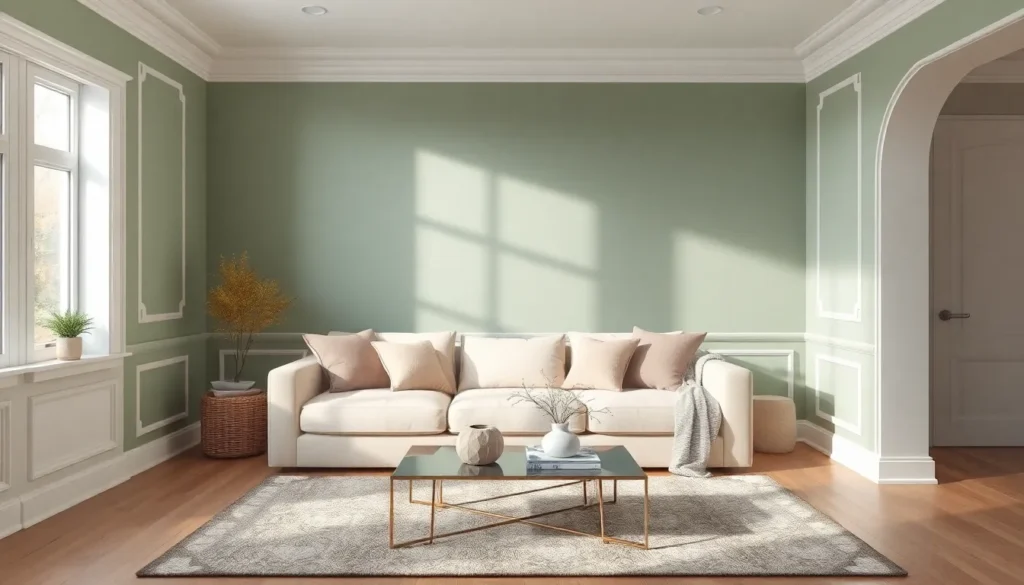Green has become the ultimate power color for transforming living rooms into serene yet sophisticated spaces. We’re seeing homeowners everywhere embrace this versatile hue that brings the calming essence of nature indoors while creating stunning visual impact.
Whether you’re drawn to deep forest greens that add drama and elegance or prefer soft sage tones that promote relaxation, the right green paint can completely revolutionize your living room’s atmosphere. We’ve discovered that green works beautifully with virtually any design style – from modern minimalist to traditional farmhouse.
The best part? Green paint offers endless possibilities for creating a space that’s both trendy and timeless. We’ll show you how different green shades can make your living room feel larger, cozier, or more luxurious depending on your goals and existing décor.
Sage Green: The Perfect Neutral for Modern Living Rooms
Sage green offers the perfect balance between tranquility and sophistication for contemporary living spaces. This muted green tone works beautifully as both a statement wall color and an all-over room treatment.
Pairing Sage Green with White Trim and Accents
White trim creates stunning contrast against sage green walls while maintaining the room’s serene atmosphere. We recommend using crisp white baseboards, crown molding, and window casings to frame the sage backdrop elegantly. White accent pieces like throw pillows, ceramic vases, and picture frames help brighten the space without overwhelming the calming effect.
Cream or off-white alternatives work equally well when you prefer a softer contrast. These warmer neutrals complement sage green’s natural undertones while creating visual depth. Consider incorporating white furniture pieces such as coffee tables, bookcases, or accent chairs to establish focal points throughout the room.
Natural wood elements in light oak or maple tones bridge the gap between sage walls and white accents. Wooden side tables, floating shelves, or exposed ceiling beams add warmth while maintaining the modern aesthetic. This combination creates a sophisticated color palette that feels both current and timeless.
Creating a Spa-Like Atmosphere with Sage Walls
Sage green walls instantly transform living rooms into peaceful retreats reminiscent of luxury spas. The color’s connection to nature promotes relaxation while its muted intensity prevents overstimulation. We suggest painting all four walls in sage when you want maximum impact and complete immersion in the calming environment.
Textural elements enhance the spa-like feeling when combined with sage paint. Woven baskets, linen curtains, and natural fiber rugs add layers of comfort while maintaining the serene mood. These organic textures work harmoniously with sage green’s earthy qualities to create an authentic wellness-inspired space.
Soft lighting completes the spa atmosphere by highlighting sage green’s subtle variations throughout the day. Table lamps with warm LED bulbs create gentle pools of light that make the color appear richer in the evening. Natural light during daytime hours brings out sage green’s fresh, revitalizing qualities that energize without overwhelming the senses.
Forest Green: Bold Statement Walls That Command Attention
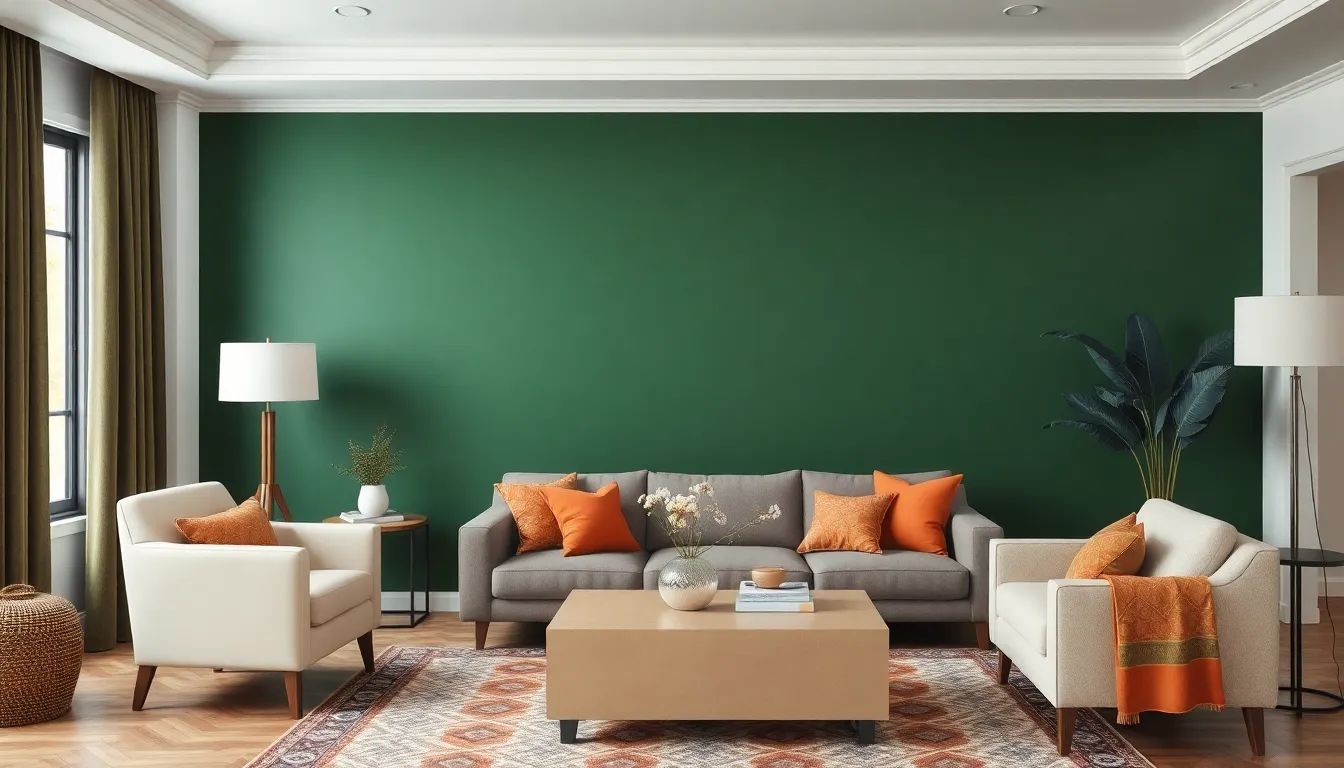
Forest green delivers the dramatic impact that transforms ordinary living rooms into sophisticated spaces with natural elegance.
Using Forest Green as an Accent Wall Behind the Sofa
Creating a stunning focal point starts with positioning forest green behind your main seating area. This strategic placement draws attention to the conversation zone while establishing the sofa as the room’s centerpiece. We recommend choosing the wall that naturally frames your largest furniture piece to maximize visual impact.
Forest green accent walls bring natural elements indoors without overwhelming the entire space. The deep, rich tone creates depth and dimension that makes your living room feel more expansive rather than closed in. This approach allows you to experiment with bold color while maintaining design flexibility throughout the rest of the room.
Positioning matters significantly when working with forest green accent walls. We suggest avoiding walls with multiple windows or doorways, as these interruptions can fragment the color’s dramatic effect. Instead, select a solid wall surface that provides an uninterrupted canvas for the forest green to make its statement.
Balancing Dark Green with Light-Colored Furniture
Light colored furniture creates the perfect counterbalance to forest green’s intensity. White, cream, and beige upholstery prevents the room from feeling too dark while allowing the green to remain the star. We’ve found that this contrast approach makes spaces feel larger and more inviting than monochromatic schemes.
Strategic furniture placement enhances the forest green’s sophisticated appeal. Position your lightest pieces, such as white armchairs or cream colored coffee tables, directly against or near the green wall to create maximum visual contrast. This technique helps define different zones within your living room while maintaining cohesive flow.
Complementing forest green with earthy tones like beige, brown, and terracotta brings harmony to the space. These natural colors work alongside your light furniture to create a balanced palette that feels grounded and welcoming. We recommend incorporating these tones through throw pillows, area rugs, or decorative accessories rather than major furniture pieces.
Mint Green: Fresh and Airy Options for Smaller Spaces
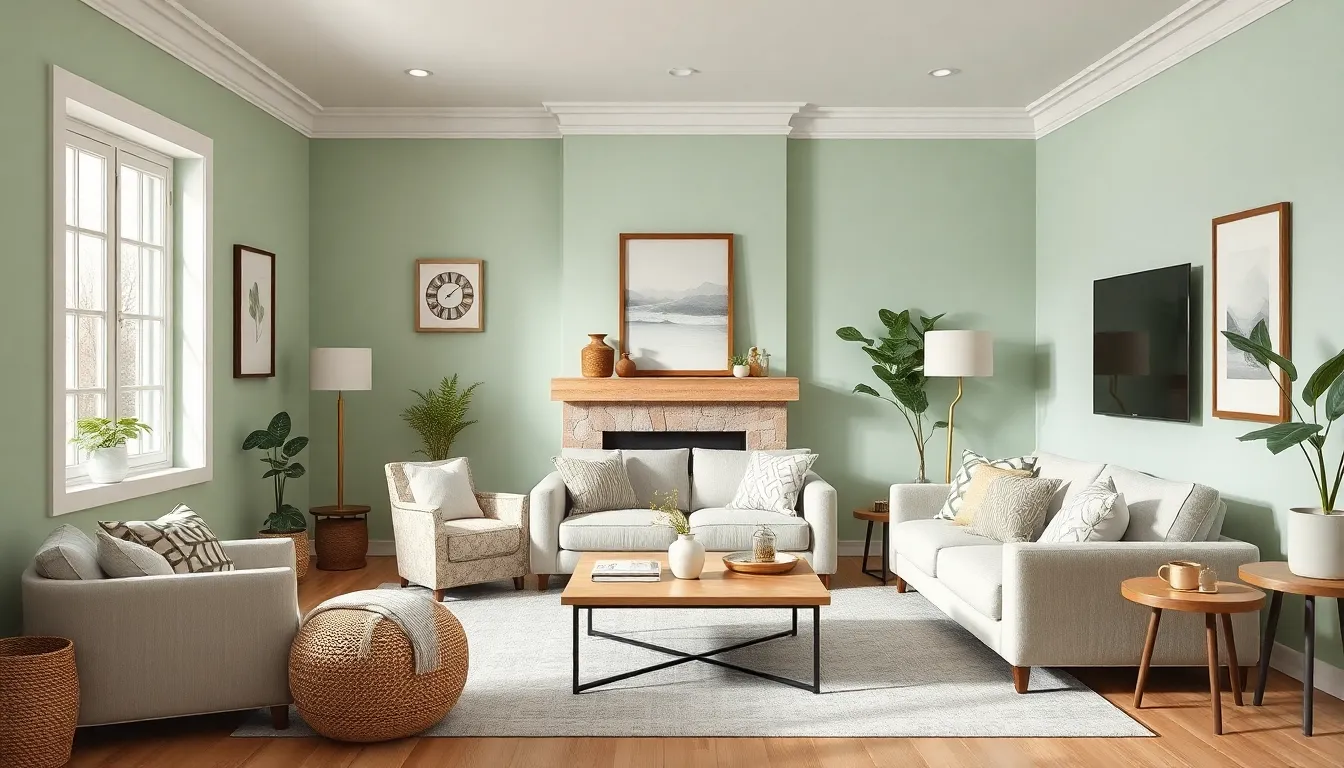
Mint green offers a refreshing departure from deeper forest tones while maintaining the calming benefits of green in compact living spaces. This lighter shade creates an illusion of openness that makes smaller rooms feel more spacious and breathable.
Creating a monochromatic mint scheme allows us to add visual depth without overwhelming limited square footage. Different shades of mint green work together to create a soothing yet varied color palette that prevents monotony while maintaining the fresh, airy feeling we’re after.
Pairing mint walls with cream furniture establishes a timeless combination that feels both inviting and harmonious. This neutral pairing creates a sophisticated backdrop that won’t compete for attention in smaller spaces where every design choice matters.
Hiding everyday wear becomes easier with mint green walls since this shade effectively conceals stains and scuff marks that occur in high traffic areas. We find this practical benefit particularly valuable in compact living rooms where furniture placement limits wall protection.
Incorporating Mint Green in Open-Concept Living Areas
Coordinating with other green shades creates a natural flow throughout open concept spaces without jarring color transitions. Forest green and sage green work seamlessly with mint to establish visual continuity between different zones.
Balancing mint with sophisticated grays allows the freshness of this lighter green to shine without overwhelming the entire space. Gray elements provide grounding that prevents mint from appearing too juvenile or overwhelming in larger, connected areas.
Defining separate zones becomes simpler when we use mint green strategically on accent walls or exact areas within the open floor plan. This approach creates subtle boundaries while maintaining the cohesive feel that makes open concepts successful.
Combining Mint with Natural Wood Elements
Adding wooden furniture pieces introduces warmth and texture that complements mint green’s cool freshness perfectly. Natural wood beams, coffee tables, or accent pieces create visual interest while softening the crispness of mint walls.
Incorporating earthy tones like sage and terracotta through accessories enhances the natural feeling when combined with wood elements. These earth inspired colors work together to create a cozy, inviting atmosphere that feels grounded and organic.
Creating contrast through texture becomes essential when combining smooth mint walls with natural wood grain. We recommend mixing different wood finishes and textures to add visual depth while maintaining the fresh, natural aesthetic that makes this combination so appealing.
Olive Green: Earthy Tones for Cozy Living Room Vibes
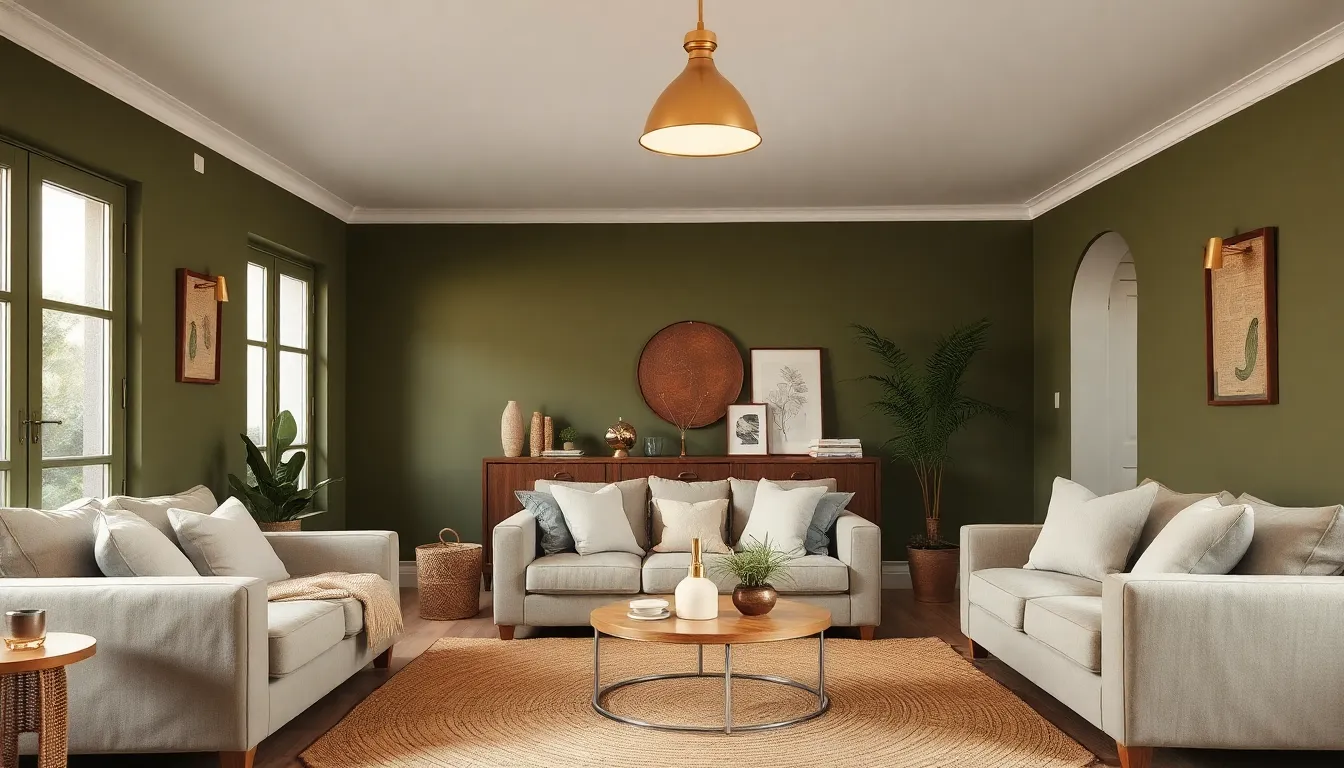
Olive green brings sophisticated warmth to living rooms while maintaining the calming qualities we’ve explored with other green shades. This versatile earth tone creates an elevated atmosphere that feels both grounded and refined.
Styling Olive Green with Warm Brass Hardware
Brass fixtures elevate olive green walls by introducing metallic warmth that complements the paint’s natural undertones. We recommend choosing warm brass finishes for lighting fixtures, cabinet pulls, and decorative elements to create a cohesive sophisticated look. Hardware in this finish prevents olive green from feeling too casual while adding an upscale touch that transforms ordinary rooms into designer spaces.
Strategic placement of brass elements maximizes their impact against olive green backgrounds. Statement lighting like brass pendant lights or table lamps creates focal points that draw attention upward. Door handles, window hardware, and picture frames in matching brass finishes tie the entire room together seamlessly.
Temperature coordination between olive green and brass creates visual harmony throughout the space. Both elements share warm undertones that naturally complement each other without competing for attention. This pairing works especially well in traditional and transitional design styles where classic elegance takes precedence.
Adding Texture with Olive Green and Natural Fabrics
Natural fabrics introduce tactile interest that prevents olive green rooms from feeling flat or one dimensional. Linen upholstery, cotton throw pillows, and jute rugs add layers of texture that create depth against painted walls. These organic materials enhance olive green’s earthy qualities while providing visual and physical comfort.
Layering different fabric weights creates sophisticated contrast within the olive green color scheme. Heavy linen curtains paired with lightweight cotton throws establish visual rhythm that keeps the eye engaged. Woven textures like basket weave or herringbone patterns add subtle detail without overwhelming the space’s serene atmosphere.
Strategic fabric placement throughout olive green living rooms maintains balance while adding warmth. We suggest concentrating textured fabrics in seating areas where people naturally gather and touch surfaces most frequently. Natural fiber rugs anchor furniture groupings while providing softness underfoot that complements the paint’s cozy appeal.
Color coordination between natural fabrics and olive green walls requires careful attention to undertones. Cream and ivory fabrics create gentle contrast that brightens the space without harsh transitions. Warm beige and taupe textiles maintain the earthy palette while adding neutral balance that prevents the room from feeling too monochromatic.
Emerald Green: Luxurious Jewel Tones for Dramatic Impact
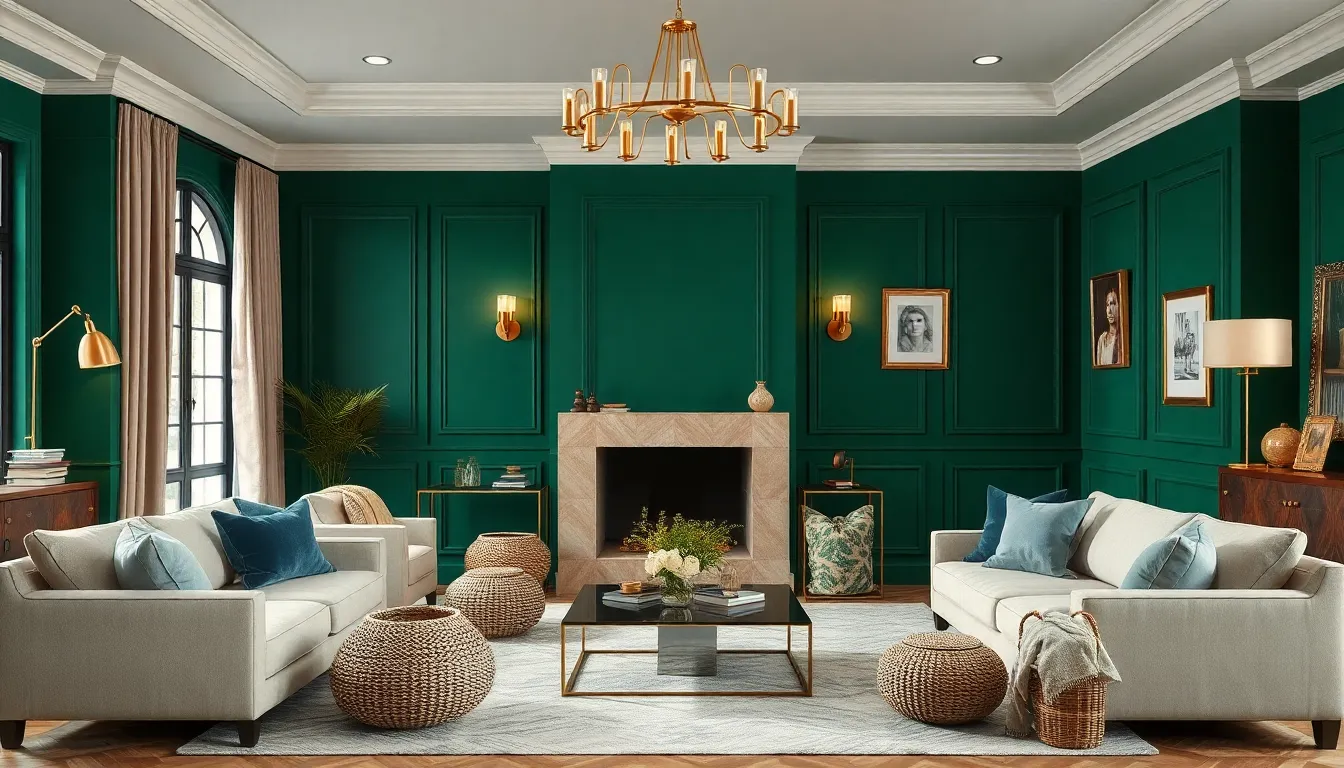
Emerald green delivers unmatched luxury while creating sophisticated depth that transforms ordinary living rooms into jewel toned sanctuaries. This rich shade commands attention without overwhelming the space when balanced properly with complementary colors and textures.
Creating Elegance with Emerald Green Feature Walls
Feature walls in emerald green establish dramatic focal points that anchor your entire room design. Position your emerald accent wall behind the main seating area to draw the eye while maintaining visual balance throughout the space. Bold emerald tones create striking backdrops that make furniture and artwork pop against their rich surface.
Balance emerald intensity with neutral colored furniture to prevent color overwhelm. Choose cream, white, or light gray upholstery pieces that allow the green wall to shine without competing for attention. Soft textures through area rugs and throw pillows add dimensional interest while keeping the palette cohesive.
Layer different textures against emerald walls to create sophisticated depth. Incorporate woven baskets, velvet cushions, and natural wood elements that complement the green’s richness. These textural variations prevent the space from feeling flat while improving the luxurious atmosphere emerald green naturally provides.
Pair emerald feature walls with other jewel tones for maximum drama. Deep purples, rich burgundies, and warm golds create stunning color combinations that feel intentional and sophisticated. This multi color approach works especially well in larger living rooms where bold choices won’t overwhelm the space.
Incorporating Metallic Accents with Emerald Paint
Gold accents create the most classic pairing with emerald green for timeless elegance. Choose brass lighting fixtures, gold picture frames, and warm metallic hardware that enhances emerald’s natural luxury. This combination feels both traditional and contemporary depending on your furniture choices and overall styling approach.
Mix different metallic finishes to add modern sophistication to emerald rooms. Combine warm brass with cool silver or copper elements for unexpected visual interest that keeps the space from feeling too predictable. Strategic placement of mixed metals throughout the room creates a curated, designer quality finish.
Select metallic furniture pieces that complement emerald’s richness without competing. Coffee tables with brass legs, side tables with copper details, or mirrors with gold frames add just enough shine to enhance the green walls. These metallic touches should feel integrated rather than added as afterthoughts.
Use metallic accessories to tie emerald walls into your existing decor scheme. Decorative bowls, candlesticks, and table lamps in coordinating metals help bridge the gap between your bold wall color and neutral furnishings. This layered approach creates a polished look that feels professionally designed.
Seafoam Green: Coastal-Inspired Paint Ideas for Relaxing Spaces

Seafoam green offers a perfect transition from the rich jewel tones we’ve explored, bringing ocean-inspired tranquility to living rooms through its gentle blend of soft green, light blue, and subtle gray undertones.
Achieving Beach House Vibes with Seafoam Walls
Seafoam walls create an instant coastal atmosphere that transforms ordinary living rooms into serene beach house retreats. We recommend painting accent walls in seafoam green to establish a calming focal point without overwhelming your space.
Color combinations that enhance seafoam’s coastal appeal include:
| Primary Color | Accent Color | Design Effect |
|---|---|---|
| Seafoam Green | Crisp White | Bright, airy atmosphere |
| Seafoam Green | Pale Blue | Calm, restful coastal tone |
| Seafoam Green | Navy Blue | Sophisticated nautical contrast |
| Seafoam Green | Beige | Soft, warm beach house feel |
White trim and accents work exceptionally well with seafoam walls, creating brightness that amplifies the room’s lively coastal spirit. Beige provides a softer alternative that maintains the airy effect while adding warmth to your living space.
Dark wood accents or matte black elements offer sophisticated contrast against seafoam backgrounds, preventing the color from appearing too sweet or juvenile. These deeper tones ground the space while preserving its relaxing coastal essence.
Pairing Seafoam Green with Nautical Decor Elements
Nautical accessories amplify seafoam green’s coastal charm through carefully selected decorative elements that echo ocean themes. Anchors serve as classic focal points when displayed on floating shelves or as wall art against seafoam backgrounds.
Rope details add authentic maritime texture through picture frames, light fixtures, or decorative bowls that complement the wall color. Driftwood furniture pieces introduce natural earthiness that balances seafoam’s cool tones with organic warmth.
Natural textiles like jute rugs or linen throw pillows enhance the coastal aesthetic while adding layers of texture that prevent the space from feeling flat. Woven baskets provide both storage and visual interest that reinforces the beach house atmosphere.
Soft lighting creates the cozy ambiance essential for coastal living rooms, with warm bulbs that make seafoam walls appear more inviting during evening hours. Table lamps with rope bases or pendant lights in weathered finishes complete the nautical theme while providing functional illumination.
Strategic placement of these nautical elements ensures they enhance rather than overwhelm your seafoam green living room, creating a cohesive coastal sanctuary that feels both relaxing and sophisticated.
Two-Tone Green Paint Combinations for Added Visual Interest
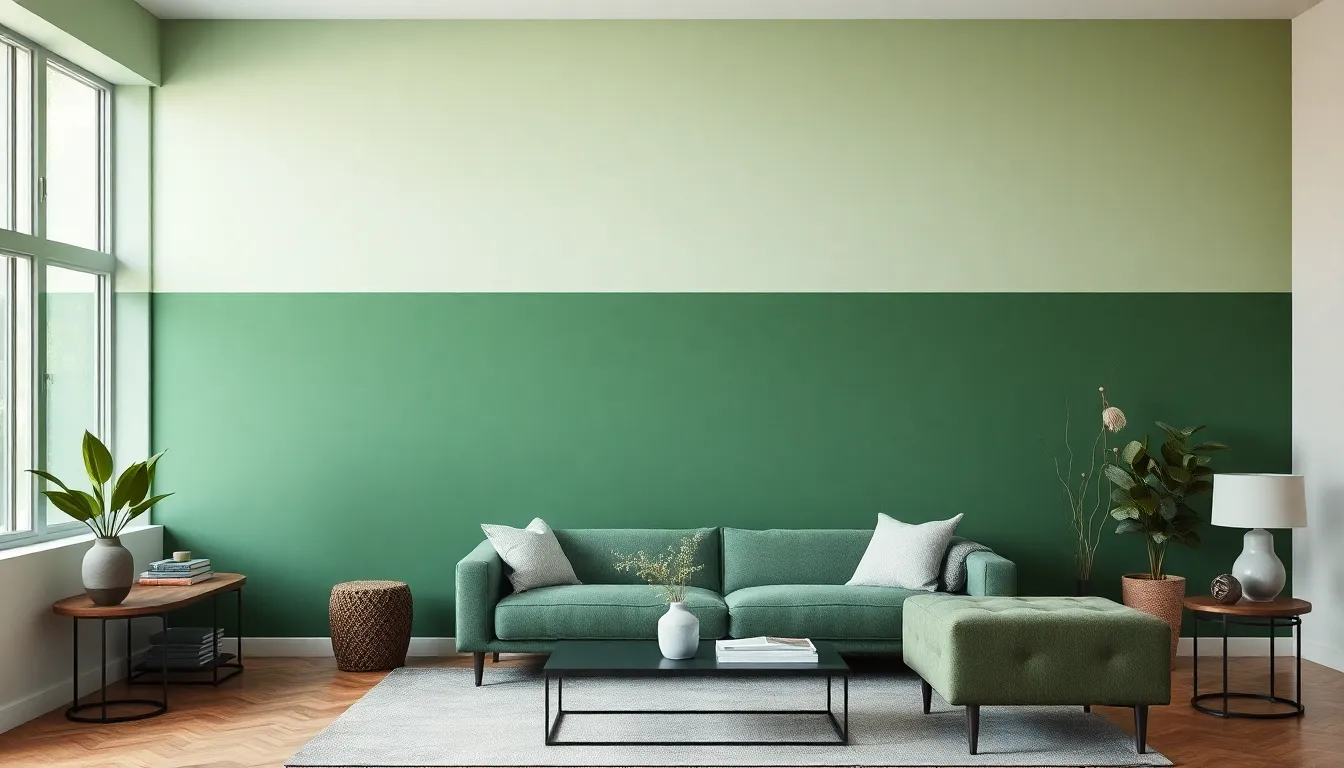
Two-tone green combinations let you create ever-changing visual depth while maintaining the calming essence we’ve explored with single-shade approaches. These strategic color pairings add sophistication and dimension that single-color schemes simply can’t match.
Mixing Light and Dark Green Shades on Different Walls
Light sage upper walls paired with deep forest green lower sections create stunning visual balance in your living room. Position the darker shade on the bottom third of your walls to ground the space while keeping the upper portion bright and airy. This combination works particularly well in rooms with standard 8-foot ceilings, as it draws the eye upward.
Accent walls using contrasting green tones transform ordinary rooms into sophisticated spaces with minimal effort. Choose one wall for a bold emerald green treatment while keeping the remaining three walls in soft mint or seafoam. We recommend selecting the wall behind your main seating area for maximum impact.
Horizontal color blocking with complementary greens adds modern flair to traditional living rooms. Apply olive green to the upper two-thirds of your walls and sage green to the lower third for a contemporary twist on classic design. This technique makes ceilings appear higher while creating visual interest at eye level.
Creating Wainscoting Effects with Contrasting Green Tones
Traditional wainscoting with darker green bases establishes timeless elegance in your living room design. Paint the lower third of your walls in deep forest green and the upper portion in soft sage to create the classic wainscoting look without installing actual molding. This approach costs significantly less than traditional wainscoting while delivering similar visual impact.
Modern inverted wainscoting using lighter green bases offers a fresh take on conventional color placement. Apply mint green to the bottom third of your walls and rich olive green above the imaginary chair rail line. This unexpected combination creates contemporary sophistication that feels both grounded and uplifting.
Textural wainscoting effects with matte and satin finishes add depth without requiring multiple paint colors. Use the same green shade in different sheens to create subtle contrast between your upper and lower wall sections. Apply satin finish below the chair rail height and matte finish above for sophisticated visual separation.
Green Paint Finishes That Work Best in Living Rooms

Selecting the right paint finish determines how your green living room walls will look and perform over time. We’ll explore the three most popular finish options to help you make the best choice for your space.
Choosing Between Matte, Eggshell, and Satin Finishes
Matte finish delivers a completely flat appearance without any shine, making it perfect for hiding wall imperfections and creating a sophisticated look. This finish works beautifully with deeper green shades like forest or emerald green because it absorbs light rather than reflecting it. But, matte paint shows marks and stains more easily, requiring gentle cleaning methods that won’t damage the surface.
Eggshell finish provides a subtle sheen that’s barely noticeable while offering better durability than matte options. We recommend this finish for most living rooms because it strikes an ideal balance between aesthetics and practicality. Eggshell works exceptionally well with sage green and olive green tones, as the slight sheen enhances their natural warmth without creating unwanted glare.
Satin finish offers a moderate sheen level that makes cleaning significantly easier while providing excellent moisture resistance. This finish reflects more light than matte or eggshell, which can make lighter green shades like mint or seafoam appear more vibrant. The increased durability makes satin an excellent choice for homes with children or pets.
Considering Durability and Maintenance for High-Traffic Areas
Satin finish stands out as the top choice for high-traffic living rooms due to its superior durability and maintenance benefits. This finish withstands regular scrubbing better than matte or eggshell alternatives, making it ideal for busy family spaces where walls face frequent contact.
Light Reflectance Value (LRV) becomes crucial when selecting finishes for green paint colors in well-used areas. Higher sheen finishes like satin reflect more light and can make scuff marks less noticeable on medium-toned greens such as Benjamin Moore’s Saybrook Sage or Sherwin-Williams’ Evergreen Fog.
Maintenance requirements vary significantly between finish types, with satin allowing for easy spot cleaning using mild soap and water. Matte finishes require more careful cleaning approaches and may need touch-ups more frequently in areas where furniture brushes against walls. Regular dusting becomes more important with higher sheen finishes to maintain their appearance and prevent buildup that can dull the green color’s vibrancy.
Lighting Considerations When Using Green Paint in Living Rooms

Natural and artificial lighting significantly impact how green paint appears in your living room. We’ll explore how different light sources can enhance or diminish your chosen green shade.
How Natural Light Affects Different Green Paint Shades
Light green shades transform dramatically under natural light exposure. Natural sunlight enhances the brightness and freshness of pale mint and soft sage walls, making them appear more vibrant throughout the day. We notice that rooms facing east receive cooler morning light that can make light greens appear slightly blue-tinted, while west-facing rooms get warmer afternoon light that brings out yellow undertones.
Dark green walls create varying atmospheres depending on natural light availability. Forest green and emerald shades develop a cozy, intimate ambiance when natural light filters through, though they may appear significantly darker during cloudy days or in low-light conditions. We recommend testing dark green samples in different lighting conditions throughout the day before making final decisions.
Medium-toned greens like sage and moss respond predictably to natural light changes. These versatile shades maintain their color integrity across different lighting scenarios, making them ideal for rooms with varying natural light exposure. We’ve found that rooms with large windows showcase medium greens beautifully, as the natural light prevents them from appearing muddy or dull.
Selecting Artificial Lighting to Complement Green Walls
Warm-toned lighting fixtures create inviting atmospheres with most green paint shades. Soft white bulbs (2700K-3000K) work exceptionally well with dark green walls, improving their cozy and sophisticated appeal while preventing them from feeling cold or sterile. We suggest using warm LED bulbs in table lamps and overhead fixtures to maintain consistent color temperature throughout the room.
Cool lighting helps balance medium to light green walls effectively. Daylight bulbs (5000K-6500K) maintain the bright, airy feel of mint and seafoam green walls, preventing them from appearing too yellow or warm under artificial light. We recommend installing dimmer switches to adjust cool lighting intensity based on time of day and desired mood.
Strategic lighting placement maximizes the impact of green paint choices. Wall sconces positioned to graze green accent walls create dramatic shadows and highlights that emphasize texture and depth. We’ve discovered that uplighting bounced off light green ceilings creates ambient illumination that makes rooms feel larger and more open.
| Lighting Type | Best Green Shades | Color Temperature | Recommended Use |
|---|---|---|---|
| Warm LED | Dark green, olive | 2700K-3000K | Evening ambiance |
| Cool LED | Light green, mint | 5000K-6500K | Daytime brightness |
| Halogen | Medium greens | 3000K-3500K | Accent lighting |
| Incandescent | All green shades | 2700K | Cozy atmosphere |
Conclusion
Green paint offers endless possibilities for transforming your living room into a space that truly reflects your personal style. Whether you’re drawn to the serene qualities of sage and mint or prefer the dramatic impact of emerald and forest green each shade brings its own unique character to your home.
The key to success lies in understanding how different finishes lighting conditions and complementary colors work together. By testing samples in your exact space and considering factors like room size and natural light you’ll make confident decisions that enhance your living room’s atmosphere.
We’ve shown you how green isn’t just a color choice—it’s a design strategy that can make your space feel larger more luxurious or perfectly relaxed depending on your goals. With proper planning and attention to detail your green living room will become a welcoming retreat that you’ll love for years to come.
Frequently Asked Questions
What makes green a good color choice for living rooms?
Green brings a calming, natural essence indoors while making a strong visual statement. It complements any design style from modern to traditional and can influence the atmosphere to make rooms feel larger, cozier, or more luxurious depending on the shade chosen and existing décor.
How can sage green transform a modern living room?
Sage green acts as the perfect neutral, balancing tranquility and sophistication. When paired with white trim and natural wood elements, it creates a spa-like retreat that promotes relaxation. The color works well with cream accents and soft lighting to enhance its calming effect.
Where should I use forest green as an accent wall?
Position forest green behind your main seating area to create a stunning focal point while keeping the sofa as the centerpiece. Balance its intensity with light-colored furniture like white or cream upholstery, and complement it with earthy tones like beige and terracotta through accessories.
Is mint green suitable for small living spaces?
Yes, mint green is perfect for smaller spaces as it creates an illusion of openness. Use a monochromatic mint scheme for visual depth, pair with cream furniture for a timeless look, and balance with sophisticated grays to prevent it from appearing too juvenile.
How do I style olive green walls effectively?
Style olive green with warm brass hardware for lighting and decorative elements to create an upscale look. Add texture with natural fabrics like linen and cotton to prevent the room from feeling flat. Layer different fabric weights and colors to create visual interest and warmth.
What’s the best way to use emerald green in living rooms?
Use emerald green for feature walls to establish dramatic focal points. Balance the intensity with neutral-colored furniture and layer different textures against the walls. Incorporate metallic accents like gold and brass for timeless elegance and a designer-quality finish.
How can seafoam green create a coastal vibe?
Use seafoam walls to create a serene beach house atmosphere. Pair with crisp white for an airy feel or navy blue for sophisticated nautical contrast. Incorporate nautical decor elements like anchors and rope details, plus natural textiles and soft lighting for cozy ambiance.
What are effective two-tone green paint combinations?
Mix light and dark green shades on different walls, such as light sage upper walls with deep forest green lower sections. Try accent walls with contrasting tones like emerald against mint, or create horizontal color blocking and wainscoting effects for modern sophistication.
Which paint finish works best for green living room walls?
Matte finishes hide imperfections and work well with deeper greens. Eggshell offers subtle sheen and durability for most living rooms. Satin finishes provide moderate sheen, easy cleaning, and durability for high-traffic areas. Consider light reflectance value when choosing finishes for medium-toned greens.
How does lighting affect green paint colors in living rooms?
Natural light enhances brightness of light greens like mint and sage, while dark greens create cozy atmospheres but may appear darker in low light. Test paint samples in various lighting conditions. Use warm-toned fixtures for dark greens and cool lighting for lighter shades.

